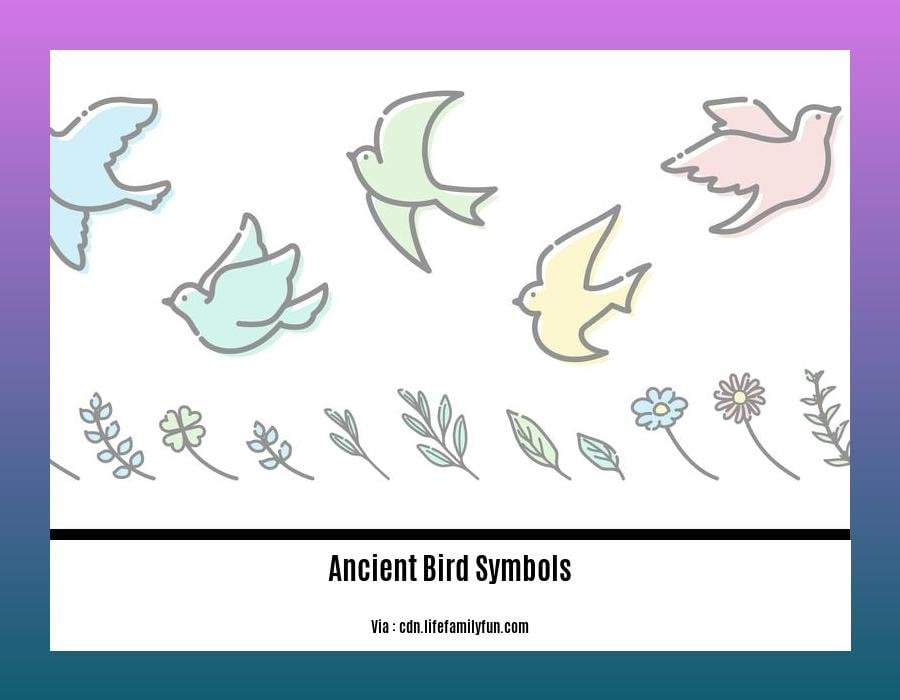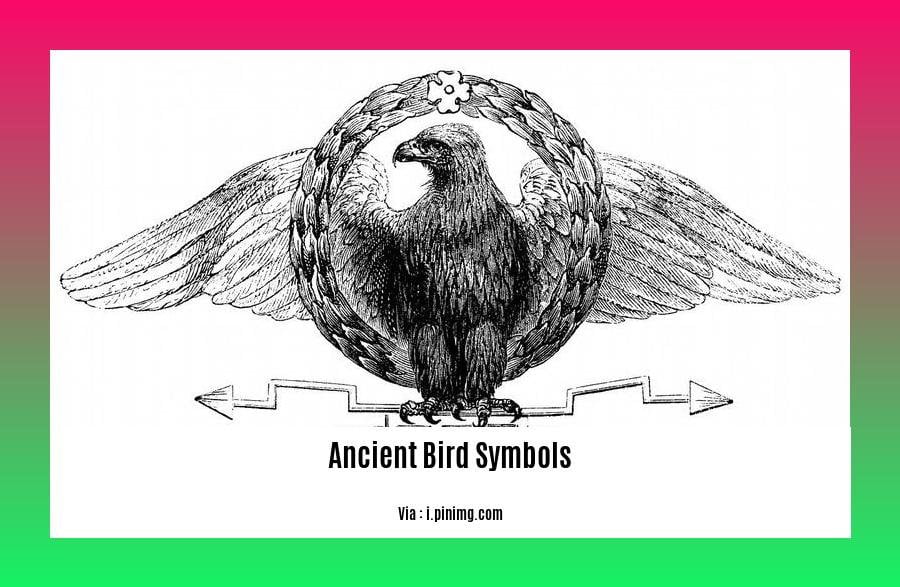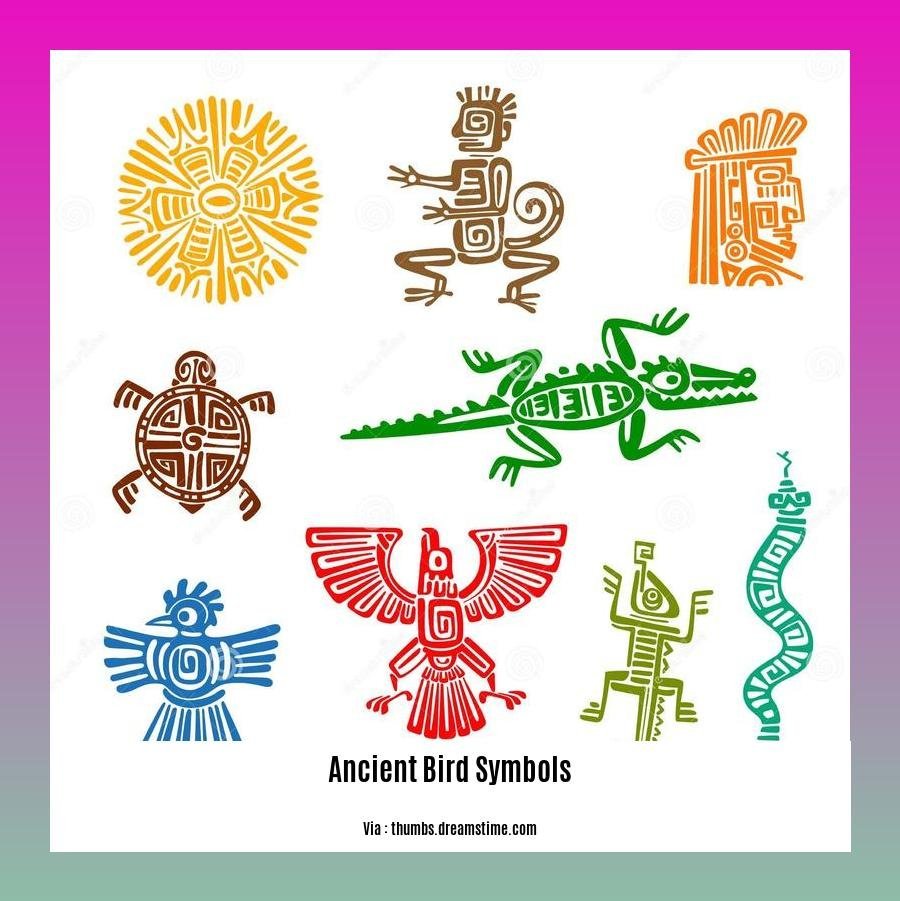Embark on a captivating journey into the world of ancient bird symbols with our comprehensive exploration entitled [Unveiling the Enigmatic Meanings of Ancient Bird Symbols: A Journey Through History and Symbolism]. Discover the profound significance birds held for various cultures across time, unraveling the intricate meanings and symbolism embedded in ancient avian imagery.
Key Takeaways:
- Ancient Egyptian Ba: Symbolized the soul, rebirth, and life after death.
- Peaceful Dove: Signified peace, love, and tranquility.
- Juno’s Peacock: Associated with beauty, dignity, and self-confidence.
- Eagle of Mexico: Represented strength and power in pre-Colombian and modern Mexico.
- Eagles of North America: Symbolized freedom, leadership, and courage.
- Phoenix: Signified rebirth, transformation, and immortality.
- Crane: Represented longevity, wisdom, and peace in Chinese culture.
- Rooster: Symbolized vigilance, punctuality, and masculinity.
Ancient Bird Symbols: Unraveling the Enigmatic Meanings

Across cultures and civilizations, the symbolism of ancient bird symbols has captivation the human imagination for millennia. These avian motifs hold deep significance, embodying diverse concepts and narratives. They have woven their way into art, mythology, literature, and religion, serving as powerful representations of spiritual beliefs, natural phenomena, and human emotions.
Journey Through History and Symbolism
Eagle (Ancient Egypt**): The revered eagle symbolized the sun god Ra, embodying strength, power, and divine authority. It adorned temples and amulets, representing the pharaoh’s connection to the heavens.
Peacock (Ancient Greece**): In Greek mythology, the peacock’s striking plumage was associated with the goddess Hera. It symbolized beauty, royalty, and majesty. The peacock’s vibrant colors were believed to ward off evil spirits.
Phoenix (Ancient China**): The mythical phoenix is a symbol of rebirth, transformation, and immortality. Legend tells of the phoenix rising from its own ashes, representing the cyclical nature of life and the triumph of spirit over adversity.
Crane (Ancient Japan**): Revered for its grace and longevity, the crane symbolized fidelity, wisdom, and good fortune. In Japanese culture, the crane is often depicted with a red crown, representing the sun and eternal life.
Dove (Ancient Christianity**): The dove carries a profound message of peace, love, and hope. In Christian iconography, the dove is associated with the Holy Spirit, representing divine guidance and inspiration.
Unveiling the Enigmatic Meanings
The diversity of ancient bird symbols reflects the interconnectedness of humanity with the natural world. Birds, with their ability to soar through the sky, became symbols of freedom, aspiration, and transcendence. Their songs and calls were interpreted as celestial messages, guiding humans through life’s journey.
Birds and Culture
In many cultures, birds were seen as intermediaries between the realms of the living and the divine. Their presence in dreams and visions was believed to carry prophetic significance. Shamans and spiritual leaders often used bird symbols as totems, representing their power and connection to the spirit world.
Birds in Modern Times
While the meanings of ancient bird symbols have evolved over time, their essence remains. In contemporary art and literature, birds continue to inspire and captivate. They evoke emotions, embody concepts, and serve as metaphors for the human experience.
Conclusion
The study of ancient bird symbols offers a glimpse into the rich tapestry of human history and culture. These symbols, with their intricate meanings and captivating stories, continue to touch our hearts and minds, reminding us of the enduring bond between humanity and the avian world.
Unravel the mysteries of ancient ancient age whiskey, the venerated spirit that has transcended epochs, captivating whiskey connoisseurs with its timeless enchantment.
Delve into the realm of ancient art tattoo, an expression of artistic mastery that melds time-honored motifs with contemporary flair, creating indelible body art that tells a tale of heritage and individuality.
Step into the ancient art tattoo studio, where skilled artisans wield their needles to immortalize stories upon skin, transforming mere ink into ethereal expressions of art and emotion.
Analyzing the diverse interpretations of bird species: How different cultures perceived and understood birds.
From majestic eagles soaring through the heavens to the melodious songs of nightingales, birds have captivated human imagination since time immemorial. Across cultures and civilizations, birds have held profound significance, inspiring awe, wonder, and reverence. Delving into the diverse interpretations of bird species offers a fascinating journey through history, symbolism, and the intricate relationship between humanity and the avian world.
Diverse Interpretations:
Birds have served as powerful symbols in various cultures, representing a multitude of concepts and beliefs. They have been associated with deities, embodying strength, wisdom, courage, and divine power. In ancient Egypt, the eagle represented the sun god Ra, symbolizing strength, power, and divine authority. In Greek mythology, the peacock was associated with the goddess Hera, embodying beauty, royalty, and majesty. The mythical phoenix, a symbol of rebirth, transformation, and immortality, held great significance in ancient Chinese culture.
Bird Symbolism in Art and Literature:
Birds have played a prominent role in art and literature throughout history. From cave paintings depicting birds as symbols of fertility and abundance to intricate tapestries and sculptures featuring birds as celestial messengers, birds have adorned temples, palaces, and cathedrals worldwide. In literature, birds have featured as protagonists, symbols, and metaphors, conveying messages of hope, love, peace, and transcendence.
Cultural and Spiritual Significance:
In many cultures, birds have been revered as sacred beings, acting as intermediaries between the living and the divine. Shamans and spiritual leaders have used bird symbols as totems, representing their power and connection to the spirit world. The presence of birds in dreams and visions has been interpreted as prophetic signs, carrying messages from the divine realm.
Birds as Cultural Messengers:
Birds have served as cultural messengers, carrying messages and symbols across vast distances. In ancient times, carrier pigeons were used to convey important messages, while migratory birds have been observed to carry seeds and pollen, contributing to the spread of plant life across ecosystems.
Key Takeaways:
- Birds have held profound significance across cultures, representing a multitude of concepts and beliefs.
- Birds have been associated with deities, embodying strength, wisdom, courage, and divine power.
- Birds have played a prominent role in art and literature, serving as symbols, protagonists, and metaphors.
- In many cultures, birds have been revered as sacred beings, acting as intermediaries between the living and the divine.
- Birds have served as cultural messengers, carrying messages and symbols across vast distances.
References:
- Culture and cultural evolution in birds: A review of the evidence
- Characterizing the cultural niches of North American birds
Investigating the cultural and artistic representations of birds: Unearthing the rich tapestry of bird symbolism in art and literature

Across countless cultures and civilizations, birds have served as rich sources of artistic and literary inspiration, carrying deep symbolic meanings that resonate with the human spirit. From ancient cave paintings to contemporary literature, birds have adorned our creative expressions, symbolizing everything from freedom and transcendence to love and transformation. Join us on a journey through history and symbolism as we delve into the captivating realm of ancient bird symbols.
A Glimpse into the Symbolism of Ancient Bird Imagery:
Eagles in Ancient Egypt: Majestic and powerful, the eagle soared through the Egyptian skies as a symbol of the sun god Ra, embodying divine authority and strength.
Peacocks in Greek Mythology: Associated with the goddess Hera, the peacock’s vibrant plumage represented beauty, royalty, and majesty, gracing temples and palaces with its elegance.
The Phoenix in Ancient China: From the ashes, the mythical phoenix rose anew, symbolizing rebirth and immortality, a beacon of hope in the face of adversity.
Cranes in Japanese Culture: Revered for their grace, longevity, and fidelity, cranes became emblems of good fortune, wisdom, and marital harmony, adorning paintings, sculptures, and textiles.
Doves in Ancient Christianity: Carrying messages of peace, love, and hope, the dove became a symbol of the Holy Spirit, a gentle reminder of divine presence.
Birds as Messengers, Guides, and Divine Intermediaries:
In ancient cultures, birds were often seen as celestial messengers, bridging the gap between the living and the divine. Their presence in dreams and visions held prophetic significance, carrying messages from the gods, ancestors, or spirit world. Shamans and spiritual leaders used bird symbols as totems, invoking their power and connection to the unseen realms.
The Enduring Legacy of Bird Symbolism in Contemporary Art and Literature:
The allure of bird symbolism continues to captivate artists and writers in the modern era. In contemporary art, birds often serve as metaphors for freedom, aspiration, and transcendence. They adorn paintings, sculptures, and installations, evoking emotions and serving as visual representations of human experiences. In literature, birds find their way into stories, poems, and plays, symbolizing love, longing, and transformation.
Key Takeaways:
Birds have been a source of artistic and literary inspiration across cultures and civilizations since ancient times.
Ancient bird symbols carry profound meanings, representing various aspects of life, nature, and the divine.
Birds often symbolize freedom, transcendence, beauty, and transformation.
In ancient cultures, birds were seen as messengers, guides, and intermediaries between the living and the divine.
Contemporary art and literature continue to draw on the rich tapestry of bird symbolism to convey emotions and explore human experiences.
Relevant URL Sources:
Birds in Art and Literature: Depictions, Symbolism, and Inspiration
Rare and Wondrous: Birds in Art and Culture, 1620–1820
Examining the enduring presence of bird symbols in our collective consciousness: Tracing the historical and contemporary significance of these avian motifs
Key Takeaways:
- Ancient Symbols: Ancient civilizations utilized birds as powerful symbols, bestowing them with significant meanings and spiritual significance.
- Cultural Expression: Birds have found their way into art, mythology, literature, and folklore, reflecting the deep connection between humans and the avian world.
- Nature’s Messengers: Birds often serve as messengers carrying divine messages, guiding souls through life’s journey, or symbolizing transformation and rebirth.
- Cultural Exchange: Bird motifs have transcended geographic boundaries, becoming universal symbols shared across cultures.
- Contemporary Relevance: In modern times, bird symbols continue to captivate artists, writers, and designers, inspiring creativity and stimulating contemplation.
- Enduring Significance: The enduring presence of bird symbols underscores their timeless appeal, as they continue to resonate with people, sparking imagination and emotion.
- Human-Nature Connection: Birds represent humanity’s profound connection to the natural world, serving as reminders of our place within the broader ecosystem.
Birds in Art, Culture, and Symbolism
Throughout history, birds have been a recurring theme in art, culture, and symbolism. From the intricate hieroglyphics of ancient Egypt to the vibrant brushstrokes of Chinese ink paintings, birds have adorned temples, palaces, and manuscripts, captivating the human imagination with their beauty and mystique.
In mythology and folklore, birds are portrayed as divine messengers, symbols of wisdom and prophecy, and harbingers of change. The ancient Greeks associated birds with specific deities, such as the majestic eagle representing Zeus, the king of gods, and the wise owl embodying Athena, the goddess of wisdom.
Birds: Messengers from the Divine
Birds have long been revered as messengers from the divine. In many cultures, birds are believed to carry messages between the realms of the living and the dead, the earthly and the celestial. The dove, with its gentle cooing and pure white plumage, is often associated with peace, love, and the Holy Spirit in Christianity.
Cultural Exchange and Shared Symbolism
Bird motifs have transcended geographic boundaries, becoming universal symbols shared across cultures. The phoenix, a mythical bird associated with rebirth and renewal, is found in both Eastern and Western mythology. Similarly, the eagle, symbolizing strength, courage, and dominion, holds a prominent place in cultures worldwide.
Contemporary Relevance and Artistic Inspiration
In modern times, bird symbols continue to captivate artists, writers, and designers, inspiring creativity and stimulating contemplation. From paintings to sculptures, from literature to film, birds serve as powerful metaphors, embodying ideas about freedom, hope, and transformation.
The Enduring Significance of Bird Symbols
The enduring presence of bird symbols underscores their timeless appeal, as they continue to resonate with people across cultures and generations. Birds, with their graceful flight, captivating songs, and symbolic meanings, have become integral to our collective consciousness, sparking imagination and emotion.
Our Connection to the Natural World
Birds represent humanity’s profound connection to the natural world. As creatures of the sky, they remind us of our place within the broader ecosystem. Their migrations, their nesting habits, and their intricate social interactions offer valuable insights into the interconnectedness of life on Earth.
Conclusion
Birds have been intertwined with human history and culture for millennia. As symbols of the divine, messengers of change, and embodiments of freedom and hope, birds continue to captivate and inspire us. Their enduring presence in our collective consciousness underscores the profound bond between humanity and the avian world.
Citation:
- Bird Symbolism: Cultural, Spiritual, and Artistic Expressions
- Birds in Art and Literature: Depictions, Symbolism, and Inspiration
FAQ
Q1: What are some notable ancient bird symbols and their associated meanings?
A1: Ancient bird symbols include the Peaceful Dove, representing peace, love, and tranquility; the Juno’s Peacock, associated with beauty, dignity, and self-confidence; and the Phoenix, symbolizing rebirth, transformation, and immortality.
Q2: How did ancient cultures perceive birds and their significance?
A2: In many ancient cultures, birds were revered as sacred beings, messengers of the divine, and harbingers of important events. They were believed to possess spiritual powers, influence the weather, and serve as guides for the souls of the deceased.
Q3: Can you explain the concept of cultural evolution in birds?
A3: Cultural evolution in birds involves the transmission of learned behaviors, such as vocal dialects, foraging techniques, and tool use, from one generation to the next through social learning. This process allows birds to adapt to changing environmental conditions and social dynamics, contributing to the diversity of bird cultures worldwide.
Q4: How have birds been depicted in art and literature throughout history?
A4: Birds have been a prevalent motif in art and literature for millennia. Paleolithic cave paintings captured their physical characteristics and behaviors, while ancient Egyptian art depicted birds with profound meanings related to life and the afterlife. In literature, birds often symbolize hope, love, freedom, or impending doom, acting as messengers or guides in various narratives.
Q5: What is the significance of birds in Chinese culture?
A5: In Chinese culture, birds are revered as symbols of freedom, messengers between heaven and earth, and objects of reverence. The Heavenly Bird represents hope, guidance, and the yearning for distant horizons. Birds were also associated with various gods and goddesses, and their imagery appears in art, literature, and spiritual beliefs throughout Chinese history.
- Sept 31 Myth: Unveiling Calendar Secrets - March 18, 2025
- How Long & Till December 18, 2025: Accurate Countdown Guide - March 18, 2025
- Discover Japanese Artists: A Complete History - March 18, 2025
















